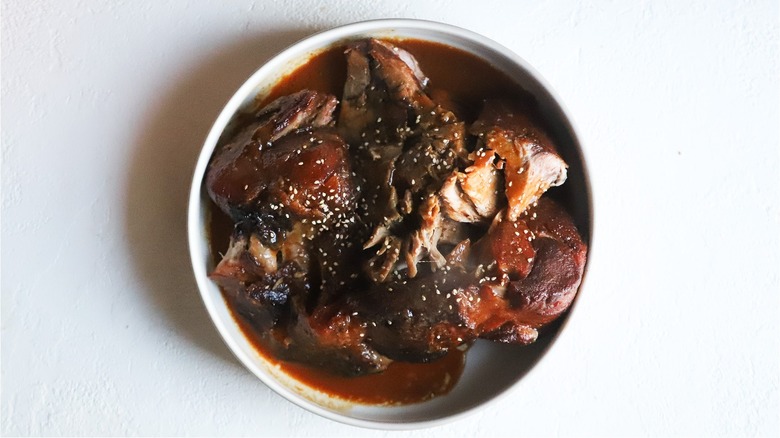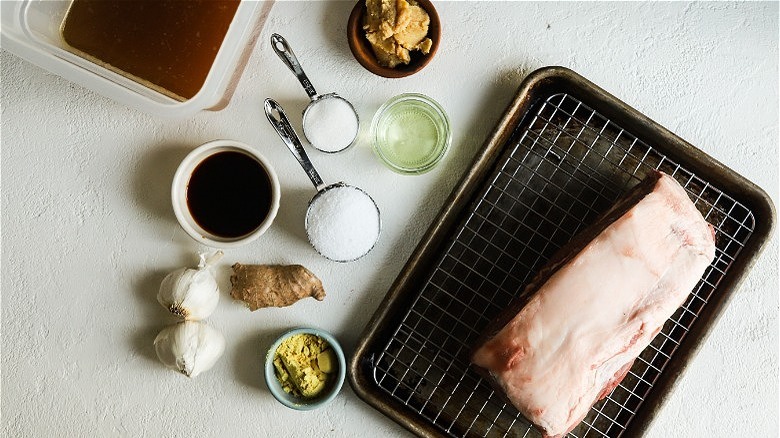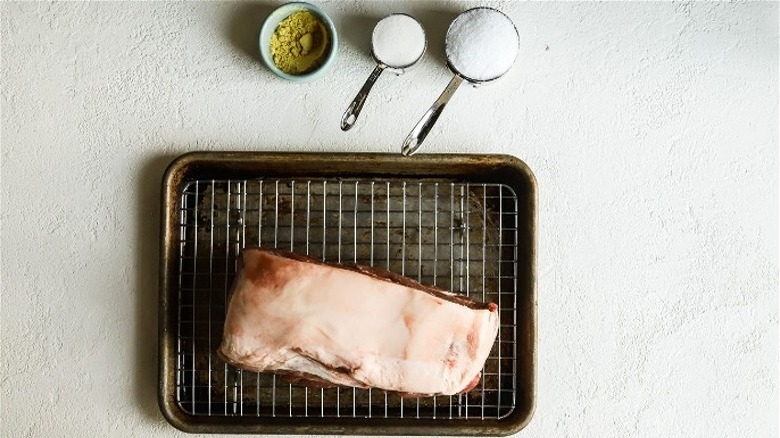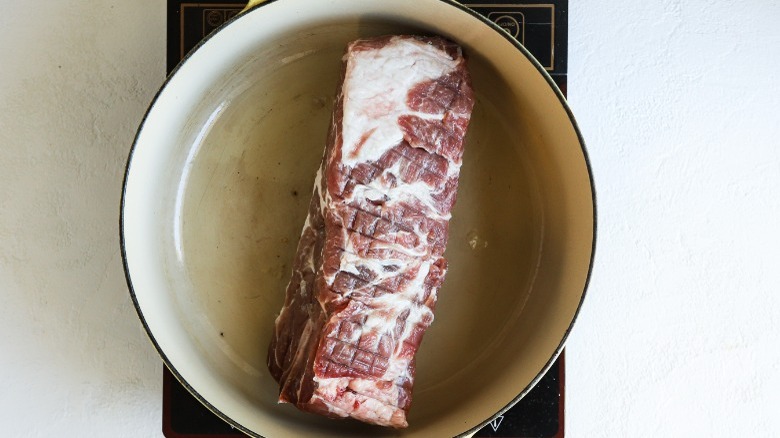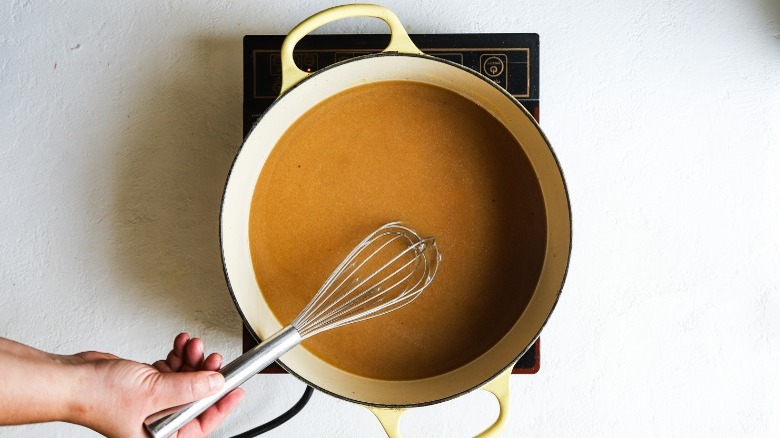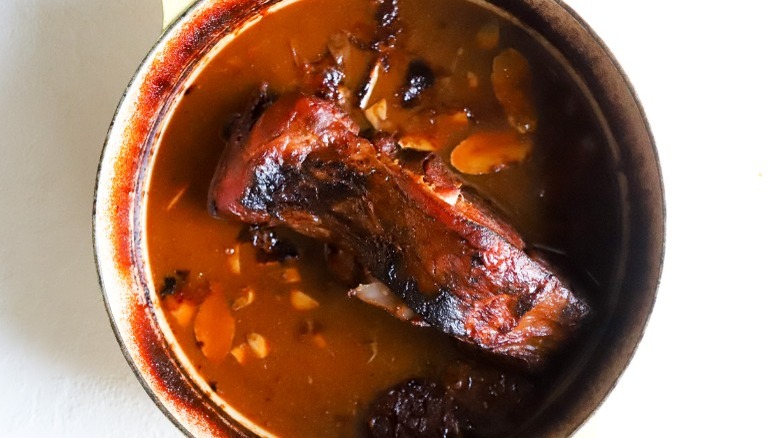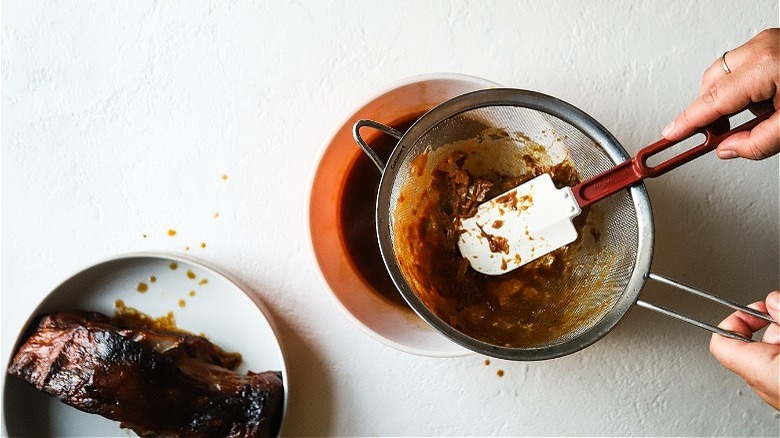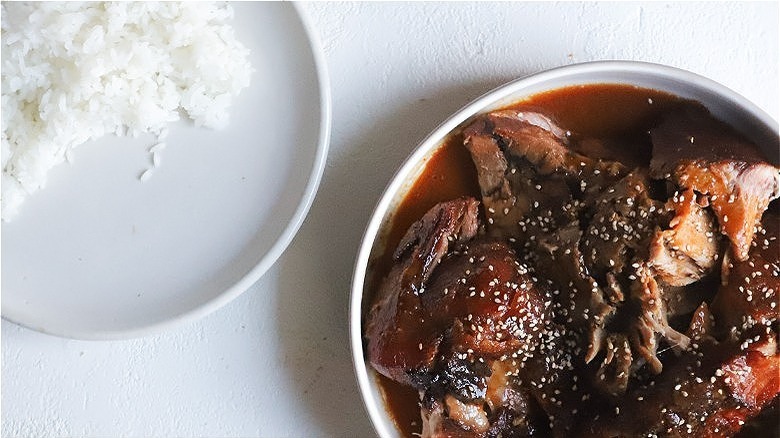Miso Mustard-Braised Pork Butt Recipe
A simple, braised pork butt is an incredible recipe to have in your back pocket. A few pantry staples can transform this cut of meat, which is often pretty affordable, into a decadent and delicious dinner. Recipe developer Taylor Murray shares her favorite braised pork recipe, which is an easy and flavorful combination of hot mustard powder and mellow white miso.
"Whenever I find a pork butt on sale at the store, I whip out this recipe," says Murray. "It's flavorful, and so easy to make." The braising liquid simmers down into a thick sauce that gets fortified with creamy cloves of roasted garlic. The final sauce is thick and full of deep umami flavors, which makes it the perfect pairing to sweet, braised pork. This recipe makes plenty of sauce, so you can spoon some over the braised pork, and still have a bit leftover for mixing with rice or noodles.
Gather the ingredients for miso and mustard-braised pork butt
First, gather all the necessary ingredients for this dish. You'll need a 3-pound pork butt, which you can get from a butcher or at your local supermarket. The recipe uses a boneless pork butt, but a bone-in pork butt will also work within the same time frame. Pork butt is a roast cut from the pork shoulder. If all you can find is pork shoulder, feel free to swap that in. Sugar, salt, and hot mustard powder come together for a simple overnight dry brine.
Finally, you'll need a couple of heads of garlic, vegetable oil, white miso, a hunk of ginger, some soy sauce, and chicken stock. YOu can also top with white sesame seeds, optionally. "Homemade chicken broth or stock is always a good idea, so if you have some in your freezer, use it here," says Murray. "The natural gelatin in the broth will make the sauce so much better."
Brine the pork
Prepare the pork for braising by making a quick dry brine. Combine the sugar, salt, and 1 tablespoon of mustard powder, then sprinkle this mixture over the pork on all sides. Refrigerate overnight, uncovered. If you don't have that much time, refrigerate for at least 5 hours.
Sear the garlic and pork
After the pork butt is done brining, remove the pork from the refrigerator, and let it sit at room temperature fro 20 minutes. Preheat the oven to 300 F. Heat the oil in a Dutch oven, and cut the garlic in half lengthwise. Add the garlic, cut-side down, and cook until browned. Remove it, and set aside. Add the pork, and sear for 2 minutes on each side until evenly browned. Remove it from the Dutch oven, and wipe it out with a paper towel.
Assemble the braising liquid
In the same Dutch oven or pot, whisk in the soy sauce, remaining 1 tablespoon of mustard powder, miso, and chicken stock. Break up any browned bits that are stuck to the bottom of the pot. Bring it to a simmer, then add the browned garlic, sliced ginger, and browned pork into the liquid.
Braise the pork
Cover the pot, place it in the oven, and braise the pork for 3 hours. At this point, there should be about 1 inch of liquid, and the pork should be browned and starting to tenderize. Then, continue to cook the pork uncovered for another 2 hours, until the pork is completely tender, and the liquid has reduced to about ¾ cup.
Strain the sauce
Once the pork is tender, remove it from the Dutch oven, and set aside. Strain the sauce through a fine-meshed sieve, making sure to press the garlic cloves out of the bulb, so the paste goes into the sauce. Skim all the fat off the surface of the sauce using a ladle or a spoon.
Serve the braised pork butt
Spoon the sauce over the meat, then lightly shred the pork into rough chunks, and spoon more sauce on top. Sprinkle some toasted sesame seeds on top, if desired. You can eat this pork as is with steamed rice and pickled vegetables, or in another dish such as lettuce wraps. This pork would also be an incredible addition to ramen with some of the sauce whisked into the broth.
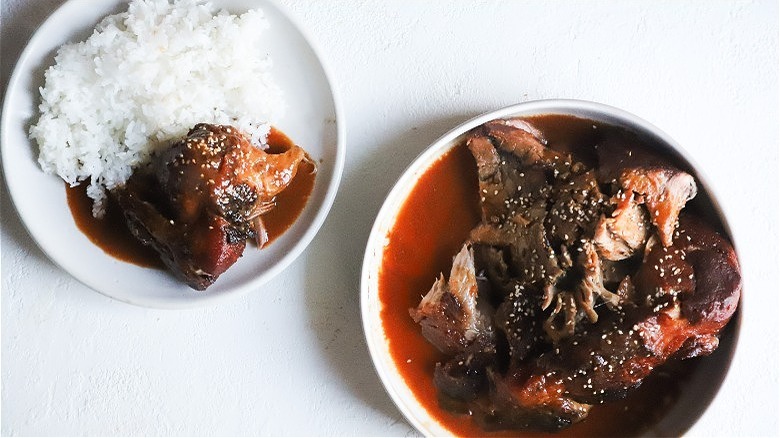
- ¼ cup kosher salt
- ½ cup granulated sugar
- 2 tablespoons hot mustard powder, divided
- 1 3-pound boneless pork butt
- 2 tablespoons vegetable oil
- 2 heads garlic, cut in half lengthwise
- 1 quart chicken stock
- 3 tablespoons white miso
- 2 tablespoons soy sauce
- 1 1-inch chunk ginger, sliced
- Toasted white sesame seeds, for serving
- Mix the salt, sugar, and 1 tablespoon of mustard powder in a bowl. Evenly coat the pork with the dry brine, and refrigerate uncovered for at least 5 hours, but preferably overnight.
- Remove the pork from refrigerator, and let it sit for 20 minutes at room temperature. Preheat the oven to 300 F. In a large Dutch oven, heat the oil over medium heat. Add the garlic, cut-side down, until golden brown. Set aside.
- Add the pork to the pot, and brown on all sides, about 2 minutes per side. Set pork aside, and remove the oil from pot with a paper towel.
- Add the stock, miso, soy sauce, and remaining mustard powder to pot, and whisk to combine. Bring to a simmer, and add garlic, sliced ginger, and browned pork.
- Cover with a lid, and place it in the oven. Cook for 3 hours, then uncover, and cook until tender and the sauce has reduced, about 2 more hours.
- Remove the pork from liquid, and set aside. Strain the braising liquid through a fine-meshed sieve, making sure to squeeze the garlic cloves out the bulb, pressing the paste though the sieve. Skim the fat from the sauce with a spoon.
- Spoon the sauce over pork. Lightly shred meat, and spoon more sauce over top. Sprinkle with sesame seeds, if using.
| Calories per Serving | 821 |
| Total Fat | 44.0 g |
| Saturated Fat | 12.7 g |
| Trans Fat | 0.4 g |
| Cholesterol | 167.5 mg |
| Total Carbohydrates | 49.1 g |
| Dietary Fiber | 2.0 g |
| Total Sugars | 30.3 g |
| Sodium | 1,572.2 mg |
| Protein | 55.9 g |
